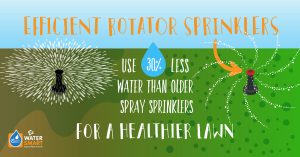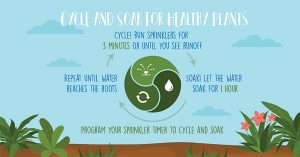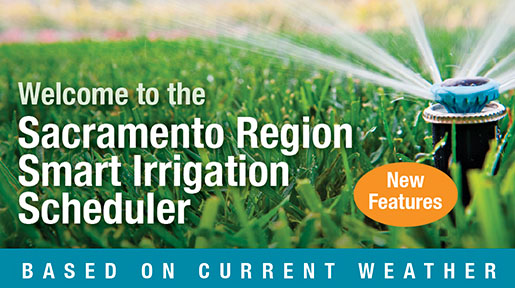By Debbie Arrington
Guest Writer
Are you wasting water in your sleep? You could be – if your landscape irrigation needs a tune-up.
“The fact is people run theirs sprinklers in the middle of the night and they never see them run,” says Don Smith, water conservation coordinator for the City of Folsom. “So they don’t know anything is wrong. People don’t think about it; your sprinkler system is out of sight, out of mind.”
Spring is when most homeowners turn their irrigation systems back on – if they ever remembered to turn them off during winter. That also makes this an ideal time for an irrigation tune-up.
“A tune-up should be the first thing you do each spring,” Smith says. “Turn everything on manually. Check your system, station by station. Look at it while it’s running. It’s something you should do at least annually at the start of the season. Inspect first, then update your equipment.”
Replacing older spray heads with high-efficiency rotator nozzles provides better irrigation coverage while using 30 percent less water than traditional sprinklers. The result: Greener grass with less water.
“I compare pop-up spray heads to Betamax video tapes,” Smith says. “They’re old news. It’s time to sunset those spray heads and replace them with newer, better technology.”
Spray heads have two big issues, Smith says. “The mist is easily wind driven and uneven application—water isn’t reaching every area of your lawn.”
Instead of creating a fine mist, rotator nozzles “give you fingers of spray that slowly rotate,” Smith says. “It gives you a very even application of water. You get water where you want it.”
Most local water providers now have rebate programs to cover retrofitting sprinkler heads and other irrigation updates. For the program for your area, check out rebates and resources at BeWaterSmart.info.
“Most times, you don’t have to replace the whole head – just the nozzle,” Smith explains. “It’s really simple to do.”
To get the best performance out of high-efficiency sprinkler heads, they need to run longer, Smith notes. “It’s counter intuitive. But less water goes out, so they need to run longer.”
Whether using high-efficiency sprinklers or standard spray, remember to cycle and soak, Smith says. “Slow application soaks in better. Your lawn will be much better off for it.”
Once lawn irrigation reaches run-off stage, no more water will soak in, he explains. “After that, you’re not watering the lawn anymore; you’re watering the sidewalk or street.”
First, determine how long you can run your sprinklers before you see run-off; this could be as little as three minutes with spray heads or 10 minutes with rotator heads. Set your timer to operate the sprinklers just below that run-off point. Then schedule a second run time an hour or 90 minutes later.
“Instead of running off, that second application will actually soak in deeper,” Smith says. “That gets water deeper into the root zone and helps your lawn become more drought tolerant. It’s just healthier.”
Such scheduling is much easier with a smart sprinkler timer, which also are covered by several local rebate programs. “If you’re using a 20-year-old or older mechanical controller, change it,” Smith says. “It can’t be efficient. It’s like a light switch; it turns sprinklers on and off, that’s it.”
Investigate trouble spots
While doing your visual inspection, some trouble spots will be obvious; a sprinkler head clipped by a lawnmower may have turned into a fountain. Wrong-way heads may be watering sidewalk instead of turf.
“Walk around and look,” Smith says. “The problem may be as simple as turning a head in the right direction.”
Other issues may take investigation.
“You may notice one area is really dry while another is really wet,” Smith notes. The solution usually is not to increase sprinkler time but adjust where the water hits.
Smith recently saw a classic wet-dry example. “The homeowner said, ‘I keep turning the water up to green up the dry spot and it’s not working,’” Smith recalls. “The problem: A sprinkler head had been turned around and was facing the driveway. Besides soaking the driveway, the water flowed to the low side—and never hit the dry spot—so the extra water was not helping. The homeowner said, ‘I wondered why my car always was water spotted.’”
Request a free Water Wise House Call
Water efficiency experts such as Smith know what to look for during Water Wise House Calls, a free service offered by many local water providers.
“Water Wise House Calls—those are our bread and butter,” Smith says. “Our approach is always to help people. Call up your agency and ask for help. We’ll come out and do our best that we can to help out.”
Learn more:
- How to Tune Up Your Sprinklers
- How to Have a Healthy Lawn with 30% Less Water—all about efficient sprinklers, including videos that show you how easy it is to switch older sprinkler heads with high-efficiency rotators
- Rebates and Free Services Offered by Local Water Providers
Debbie Arrington is a longtime home and garden reporter and co-author of the blog Sacramento Digs Gardening: https://sacdigsgardening.blogspot.com/



